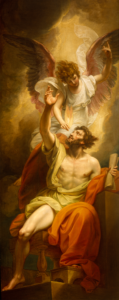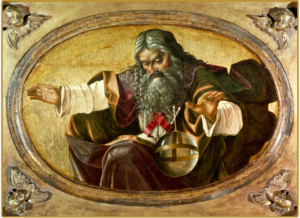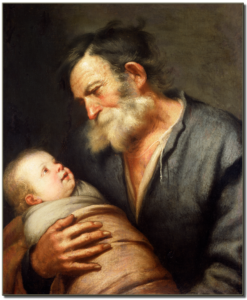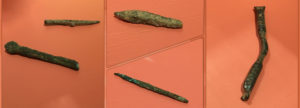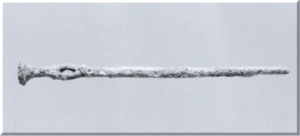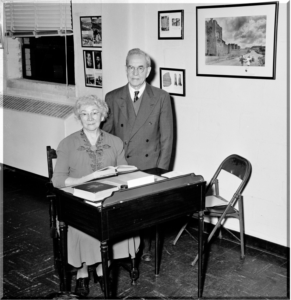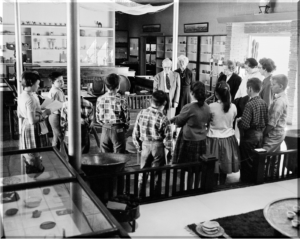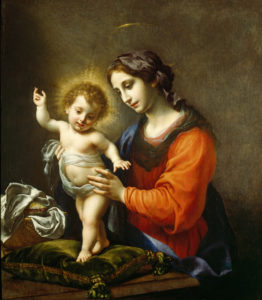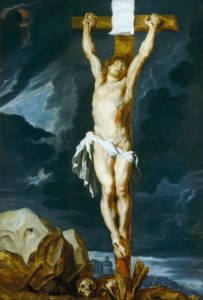In addition to highlighting traditional symbols associated with John the Baptist, Castillo’s painting illustrates how renderings of this prophet changed over time.
Category Archives: Instagram
Isaiah’s Lips Anointed with Fire
Benjamin West, P.R.A.
Below the image, click play to listen.
You can learn more about the entire series by West and M&G’s significant collection from the series HERE.
God the Father
Tempera on panel
Cristoforo Scacco
Veronese, active c. 1500
Salvator Mundi
Oil on panel
Hendrick Goltzius (attr. to)
Dutch, 1558—1617
St. Mary Magdalene Turning from the World to Christ
Oil on canvas
Jan Hermansz. van Bijlert
Dutch, 1587/98—1671
Technically speaking a symbol is an object that stands for something in addition to itself. However, such a definition hardly captures the depth and beauty that a carefully conceived symbol can add to an artistic work —whatever the genre. The poet William Butler Yeats once remarked, “A symbol is indeed the only possible expression of some invisible essence, a transparent lamp about a spiritual flame.” Philosopher Manly Hall also observed, “Symbolism is the language of the Mysteries. By symbols men have ever sought to communicate to each other those thoughts which transcend the limitations of language.” The orb (or globe) referenced in the following portraits provides a good example. Although in all three works the object serves as a symbol of power, the central character in each painting expands the image in a way that illuminates the symbol’s “invisible essence” and uncovers more of its “Mysteries.”
The painter of this early Renaissance work, Cristoforo Scacco, was born in Verona. Although biographical information on him is scarce, a 1499 document references his presence at the court of the Duchess Lucrezia del Balzo in Campania, the regional capital of Naples which was a thriving cultural and economic center of the time. In this portrait, Scacco portrays God the Father as “the Ancient of Days” clothed in symbolically colored garments—white representing purity, red divine love, and purple royalty. This traditional iconography is in part derived from the prophet Daniel’s dream: “I kept looking Until thrones were set up, And the Ancient of Days took His seat; His vesture was like white snow And the hair of His head like pure wool” (Daniel 7:9). However, it is the cross-bearing orb that accentuates God the Father’s sovereign power as Creator of the world. Notice that the left side of the globe is in darkness, but as the eye sweeps to the right, light “overtakes” that darkness. This imagery, coupled with the figure’s expansive gesture and downward gaze toward the orb, echoes that moment in Genesis as God hovers over the waters contemplating the void before speaking that first divine declaration. It’s but a single phrase: “Let there be light,” and radiant beauty springs forth. This radiance is not only reflected in the orb but also mirrored in the golden background that frames the Creator.
 In this second portrait by the Dutch painter Hendrick Goltzius we shift our focus from the power of Father to that of the Son. Salvator Mundi meaning “Savior of the World,” was a popular subject for painters from the 15th through the 17th centuries. Here Goltzius depicts a vigorous, authoritative Christ. His right hand is raised in His customary sign of blessing, and He is dressed in the symbolic colors of red (love) white (purity) blue (truth) and gold (majesty). As in the previous portrait, this painter uses a globe as his central symbol, but here the orb is predominantly black—darkened by the sin of a fallen world. Notice, however, that its surface is minutely transparent, allowing us to faintly glimpse Christ’s red mantle of love through that darkness. In addition, the orb (an object also held by earthly kings) rests in the palm of Christ’s hand, accentuating the fact that He is not only the Savior but also the ultimate Ruler of the world. The white circle of light “emerging” from the dark orb, further reifies these truths by turning the viewer’s mind to the promised return of the Savior—the Light of the World—who will make “all things new.” One other interesting comparison is that Goltzius’s background (like Scacco’s) mirrors the orb’s symbolism. In this case, the figure is framed against a black background—the halo that surrounds Christ’s head the only “illuminating” detail.
In this second portrait by the Dutch painter Hendrick Goltzius we shift our focus from the power of Father to that of the Son. Salvator Mundi meaning “Savior of the World,” was a popular subject for painters from the 15th through the 17th centuries. Here Goltzius depicts a vigorous, authoritative Christ. His right hand is raised in His customary sign of blessing, and He is dressed in the symbolic colors of red (love) white (purity) blue (truth) and gold (majesty). As in the previous portrait, this painter uses a globe as his central symbol, but here the orb is predominantly black—darkened by the sin of a fallen world. Notice, however, that its surface is minutely transparent, allowing us to faintly glimpse Christ’s red mantle of love through that darkness. In addition, the orb (an object also held by earthly kings) rests in the palm of Christ’s hand, accentuating the fact that He is not only the Savior but also the ultimate Ruler of the world. The white circle of light “emerging” from the dark orb, further reifies these truths by turning the viewer’s mind to the promised return of the Savior—the Light of the World—who will make “all things new.” One other interesting comparison is that Goltzius’s background (like Scacco’s) mirrors the orb’s symbolism. In this case, the figure is framed against a black background—the halo that surrounds Christ’s head the only “illuminating” detail.
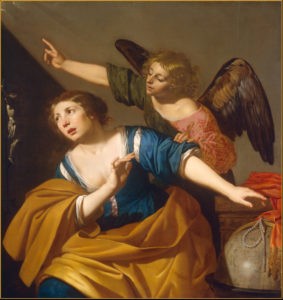 Whereas the previous two paintings use the globe to communicate universal constructs that transcend time, Jan van Bijlert uses the symbol to objectify temptations that beset us “in time.” Here again the globe symbolizes the world, but this world is pictured as a physical rather than metaphysical object—a material world as concrete as the elegant cloth and pearls draped over its surface. Art historian David Steele says, “In this work Bijlert has depicted Mary meditating upon Christ’s sacrifice. The tilt of her head, her upturned eyes, and the upward motion of her hand suggest that she is being drawn upward toward the source of divine illumination to which the angel gestures.” However, the downward thrust of her left arm toward the globe accentuates the “pull of another force” which she is rejecting—a force described in I John 2:12-17: “Do not love the world nor the things in the world. . . For all that is in the world, the lust of the flesh and the lust of the eyes and the boastful pride of life, is not from the Father, but is from the world. The world is passing away, and also its lusts; but the one who does the will of God lives forever.” In Bijlert’s rendering the globe becomes the symbol for this passing world system, the cloth and pearls the beguiling lusts that corrupt one’s love for God.
Whereas the previous two paintings use the globe to communicate universal constructs that transcend time, Jan van Bijlert uses the symbol to objectify temptations that beset us “in time.” Here again the globe symbolizes the world, but this world is pictured as a physical rather than metaphysical object—a material world as concrete as the elegant cloth and pearls draped over its surface. Art historian David Steele says, “In this work Bijlert has depicted Mary meditating upon Christ’s sacrifice. The tilt of her head, her upturned eyes, and the upward motion of her hand suggest that she is being drawn upward toward the source of divine illumination to which the angel gestures.” However, the downward thrust of her left arm toward the globe accentuates the “pull of another force” which she is rejecting—a force described in I John 2:12-17: “Do not love the world nor the things in the world. . . For all that is in the world, the lust of the flesh and the lust of the eyes and the boastful pride of life, is not from the Father, but is from the world. The world is passing away, and also its lusts; but the one who does the will of God lives forever.” In Bijlert’s rendering the globe becomes the symbol for this passing world system, the cloth and pearls the beguiling lusts that corrupt one’s love for God.
Mary Magdalene became an iconic image of penitence in the 16th and 17th centuries. Bijlert’s dramatic lighting, strong diagonal composition, and carefully conceived symbolism make this image one of the most compelling of that time.
Donnalynn Hess, Director of Education
Published in 2020
Toggle Pins
Bronze
Egyptian, 1648-1540 BC (15th Dynasty)
The Egyptian Pharaohs of the Middle Kingdom (ca. 2030–1650 B.C.) began uniting their country after years of civil war and turmoil. The Middle Kingdom brought increased prosperity and public projects which benefited all the people, not just the ruling class. History shows a variety of people groups took residence in Egypt: prisoners of war, traders, craftsmen, diplomats and more from bordering countries.
However, around 1650 BC, one of the well-established foreign groups of people, known as the Hyksos, rose to power as the 15th Dynasty. These rulers continued to maintain the Egyptian traditions and way of life, which Rosalie David explains in Handbook to Life in Ancient Egypt, “Foreign influence was minimal in the formative years of the society, allowing the distinctive Egyptian traditions to become firmly established. The culture was so all-embracing and pervasive that, when it finally encountered foreign ideas and customs, these were either readily absorbed and Egyptianized or had little or no impact on the mainstream culture.”
Egyptians focused a great deal on their outward appearance. All men, women and children wore some type of make-up both for beautification and protection from the sun. Egyptians emphasized cleanliness often bathing multiple times per day. To discourage lice, both men and women shaved their heads and wore wigs. Egyptian dress even indicated status and social class. Generally, draped and tied pieces of fabric in square or rectangular shapes formed the basic component of Egyptian garments. The most common textile was linen, which was made from flax, spun and woven by women. The linen was a natural, creamy white color or bleached pure white.
At first glance, these simple metal sticks seem insignificant. However, toggle pins served an important function in ancient civilizations. Ancient peoples used toggle pins to fasten garments closed especially cloaks and mantles much like we use buttons, zippers and other fasteners. They were often used to attach fabric at the shoulders, chest and waist. If needed, more than one could be used for added security. The array of foreigners in Egypt explains the presence of toggle pins in Egyptian excavations. The Egyptians most likely imported toggle pins or aimed their production toward Canaanite residents in Egypt since such pins were associated with Canaanite dress.
Bronze toggle pins were most common; however, the wealthy could opt for pins made of gold and silver. On occasion, pins would be formed from bone and ivory. The earliest forms were simple pins with no apparent head, but they evolved into various types such as the nail head, knob head and melon head pins. Some toggle pins contained a hole either for a string to help secure the garment or as a place to hang other decorative objects. Vere Gordon Childe in The Bronze Age: Typology describes how a pin and string were used: “To keep the pin in position a thread was passed through or tied on to its head, looped round the fold of the stuff to be fastened, and the end wound round the shaft again.”
These Toggle Pins are part of M&G’s Bowen Collection of Antiquities. Collectors Frank and Barbara Bowen took an interest in archaeology believing objects from the Holy Land could illuminate their study of the Bible. They completed five trips to the Holy Land in the 1930s-1940s collecting artifacts. They studied and researched at the American School of Oriental Research in Palestine where they met Sir Flinders Petrie, the famous English Archaeologist and Egyptologist. He became not just their teacher but also their friend, and after Petrie’s death, his wife Hilda (an active archaeologist herself) donated a number of Egyptian antiquities to the Bowens’ collection. After completing their travels, the Bowens actively sought a home for their collection eventually donating it entirely to Bob Jones College in Cleveland, Tennessee for a museum. They stayed with the collection as curators. When Bob Jones College became Bob Jones University and moved to Greenville, South Carolina, the Bowens moved as well and continued as curators and docents. Today, these Toggle Pins along with many other artifacts continue to fulfill the Bowens’ goal of “making the Bible come alive” through studying the objects used in the everyday lives of ancient peoples.
Rebekah Cobb, Registrar
Published in 2020
The Wedding Feast at Cana
Oil on canvas
Giovanni Domenico Piastrini
This magnificent 18th-century Roman work may be a rare one by Giovanni Domenico Piastrini and betrays a strong connection to his teacher Benedetto Luti. Piastrini was arguably his best pupil, though very little survives to document his life or oeuvre. Some experts believe that certain passages (for example, the handling of the male figure at the left forefront of the table, the woman at the far right of the table, and the brushwork in the kneeling figure at the extreme right) are painted as if by Luti himself. Other portions, such as the bride and groom, betray a strong connection to the early work of Luti’s other student, Placido Constanzi. While Piastrini’s style is clearly dependent on that of his teacher and his fellow student, other elements of the painting are clearly of his own derivation.
Though so little is definitively known about the painting, the one surety is the subject. Piastrini illustrates the first of Jesus Christ’s miracles (though not a public one) at the wedding feast of a friend of the family. John’s Gospel (2:1-11) clearly says that Mary was present, and that Jesus and His disciples were invited. The distinction is subtle, but important to the story.
Mary seems to be especially close to the hosts, close enough to be concerned that the wine was gone, unlike a mere guest. So Mary goes to her Son with only a statement of the need; she sees no reason to spell out her request. She knows her son. Jesus’ calling His mother, “Woman,” may seem cold, but He addresses her the same way from the cross as He directs John to care for her, a tender act under horrific conditions. The question “What have I to do with thee?” may possibly be a rebuke, but only a very gentle one considering that He resolves her concern. He was here on earth to show that He was the Messiah, not to solve a banquet shortage. However, His relationship with His mother is such that she has utmost confidence in His compassion, even in situations of social crisis. Trustingly, she issues instruction to the servants, “Whatsoever He saith unto you, do it” (v. 5). Again, only a close friend would give another’s servants an order, especially of such an open-ended nature. Jesus may not have an obligation to solve the problem, but Mary apparently feels a responsibility to save her friends from embarrassment. And Jesus is touched with compassion for her.
Piastrini places Mary next to an older woman, probably the mother of the groom who is clearly enthralled with his bride. (And, she is apparently appreciative of her wedding necklace!) Mary’s eyes are downcast submissively (remember her submissive answer to Gabriel’s surprising news?), and her hands are in the classic pose of prayer. Perhaps Piastrini reflects the Catholic tradition of Mary as the intercessor to Christ for those on earth. She has certainly interceded for the hosts, but not in any way remotely connected to eternal salvation. It is doubtful that the artist’s rendering depicts the moment she asks her Son for help since the servants are posed to pour out the water-into-wine for the governor of the feast, according to Christ’s instruction.
The governor of the feast (in the green) is clearly discussing the matter of the empty wine vessel (made of fine silver to show the importance of the occasion). The servant on the left side reassures him that there is more wine ready to serve. No one else seems to be concerned, not even Mary—now. Presumably the stone water jars which now hold wine are too heavy to pour from, so the servant in the right foreground uses a smaller silver vessel to pour the beverage into the larger silver urn from which the serving pitcher can be filled.
John carefully relates that no one knows where the latest—and best—wine has come from. Except the servants. Christ has not revealed Himself to the general public for His “hour had not yet come.” But He did reveal Himself to the common man, as He always did in His ministry, finding in them a willingness to believe in His deity that the religious leaders of the day did not. Piastrini composes his work so that the common man and the miracle itself are in the foreground of the painting and thus, in the forefront of the viewer’s mind. Christ’s upraised hand in the iconic pose of blessing shows He not only blesses the feast with His provision, but also the marriage with His presence.
Whether by a single artist or as a collaboration, The Wedding Feast at Cana celebrates the early 18th-century Roman style. The brilliant coloration of fabrics, the monumental size (almost 6×12 feet!), the gestured poses of multiple figures, and the classical architecture serving as backdrop for the staged event all contribute to a masterful late Roman interpretation of this biblical banquet scene.
Karen Rowe Jones, M&G board member
Published in 2020
